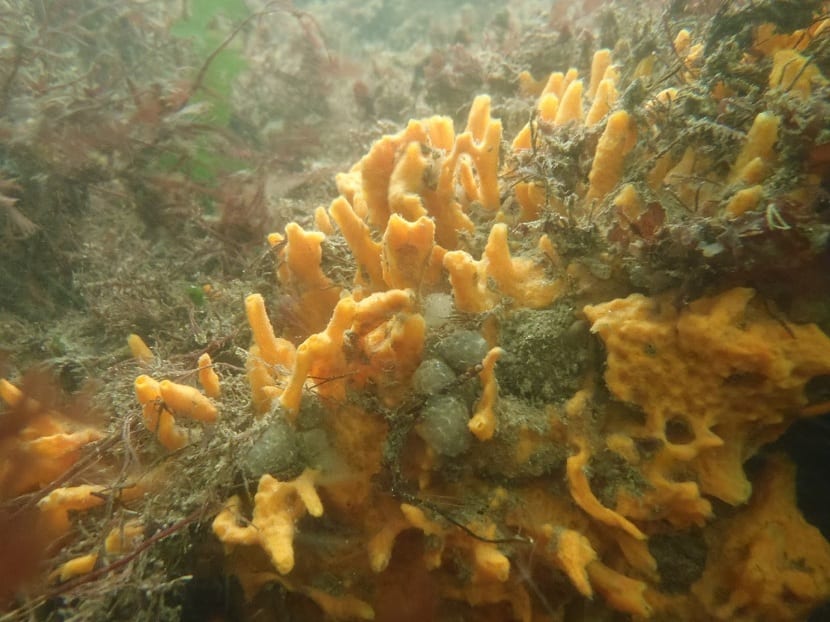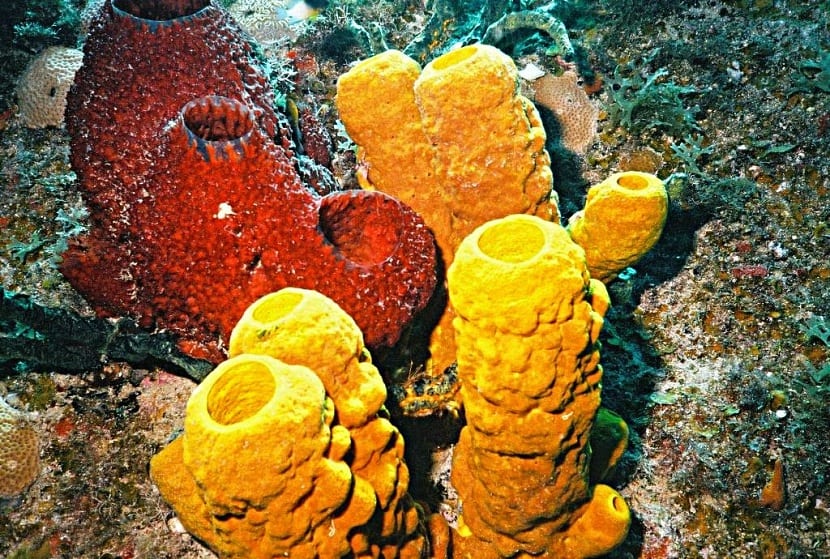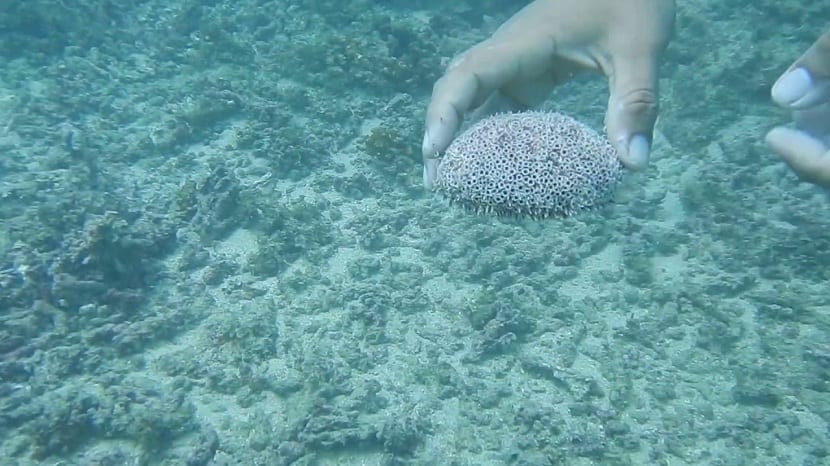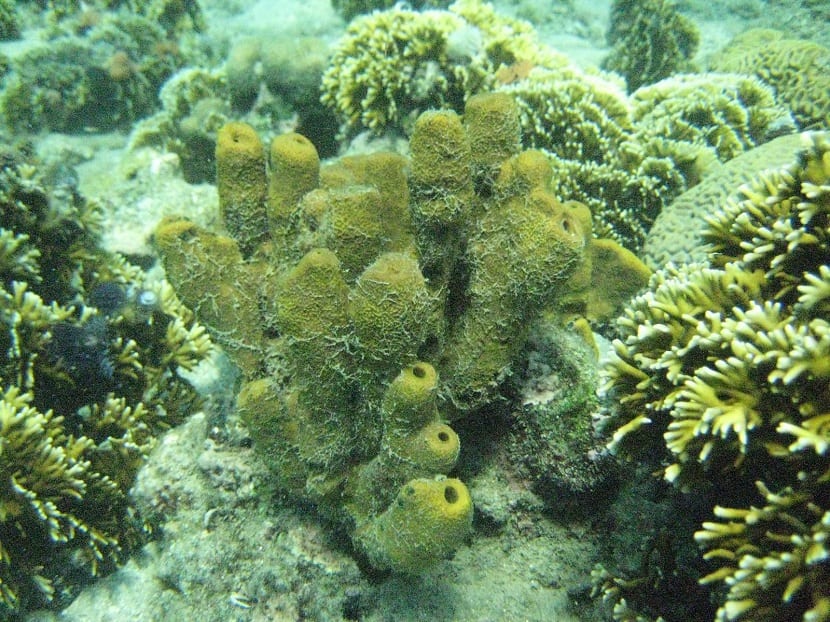
Today we come to comment on a different species to the fish we are used to. It is not a fish that we are going to deal with, but sea sponges. It is an invertebrate animal that belongs to the edge of the poriferous. They exclusively live in aquatic environments and do not present any type of movement. As its name suggests, it is nothing more than a sponge, but alive. It is among the simplest animals on the evolutionary chain, since they do not have authentic tissues.
Do you want to know all the aspects of sea sponges? If you keep reading, you will see how curious these animals are 🙂
Key features

As we have mentioned before, sea sponges are very simple animals. These are animals that do not present any type of symmetry. Their bodies do not have a definite shape, although some species show radial symmetry. The most important characteristic and is the one that gives its name to the poriferous edge is that the bodies are formed by a series of pores and channels through which the water passes and, in this way, they get food and oxygen.
Since they do not have specialized tissues, sea sponges have a large number of totipotent cells. These cells are capable of becoming any type of cell that the animal needs at any given time. This ability makes these animals very versatile when facing various situations. They have great power of regeneration even in those occasions in which it is with great losses of corporal mass.
Although the shape between sponges of different species can vary enormously, they all have a similar structure. All of them have a fairly large hole in the upper part of their body known as an osculum. It is through this hole where the water that circulates inside the sponges comes out. The walls of your body are full of pores of different sizes. It is through these pores that water enters and filtration occurs.
A type of cell unique to sea sponges are the choanocytes. This cell is specialized in filtration. Filtration is the process by which the sponge gets food. The cells have a flagellum and several microvilli that surround it and are what cause mini streams of water through which the water enters the sponge.
Range and habitat

Despite the fact that sea sponges are invertebrate animals, they are capable of adapting to different conditions. By facing situations against animals that would be impossible to beat or survive, she makes her a true survivor. They are able to tolerate water contamination by hydrocarbons quite well, metals or other harmful substances.
They have few natural predators thanks to their spicule skeleton and their great toxicity. This means that the sea sponge is found in practically all the seas and oceans of the world. The most famous sites for the large number of sponges caught in the XNUMXth century are probably the Eastern Mediterranean, the Gulf of Mexico, the Caribbean and the seas around Japan.
In terms of habitat, it is a sessile invertebrate animal. This means that they live fixed on the seabed and do not move on it. They are capable of living in great depths, although they can also be found in more superficial environments. The vast majority of them prefer environments where sunlight is not too powerful.
Sea sponge feeding

The main food of these animals is the extremely small organic particles found in the sea and that they manage to filter through their pores. But nevertheless, they can feed on plankton and small bacteria. Some sponges are capable of establishing a symbiosis with bacteria or other single-celled organisms. This relationship provides them with benefits such as access to organic matter.
There are some animals on the seabed with which you may have some mutual relationship. This type of relationship means that both parties win with the benefit of one and the other. These relationships are made up of some invertebrates or fish that use sea sponges as shelter to hide from other large predators. Certain invertebrates can become embedded in them and help them move around while camouflaging themselves. This is a clear example of a mutual relationship.
Reproduction

If they are sessile organisms without movement and without symmetry, how do they reproduce? Then They can reproduce both asexually and sexually. The first is thanks to the totipotent cells that we have seen previously. It causes them to transform into cells suitable for reproduction. The two usual forms of asexual reproduction are by budding. Some freshwater species can do this by gemulation.
Because sponges lack some specialized organs for any function, they also lack sexual organs. This can be a problem for playback. However, most individuals are hermaphrodites. They need cross-fertilization in order to reproduce properly. Both sperm and eggs develop from choanocytes. These are expelled to the outside and there is where the union between two cells takes place. Therefore, we speak of external fertilization.
Sponge development is indirect. After their development, they go through larval stages before developing into the adult individual. Four different types of larvae are known that will depend on the species.
Curiosities of sea sponges
Although they are not considered, sea sponges synthesize some toxic substances or antibiotics to keep their predators away. Many of these substances are used in the pharmaceutical industry and the properties they have against some of the most common diseases in our society are used.
They are also known to have had a relationship with humans due to their usefulness as personal hygiene tool. Currently, the purchase and sale of sponges for personal use is very controlled due to the damage that occurs in their populations.
With this information you can learn more about these primitive animals.